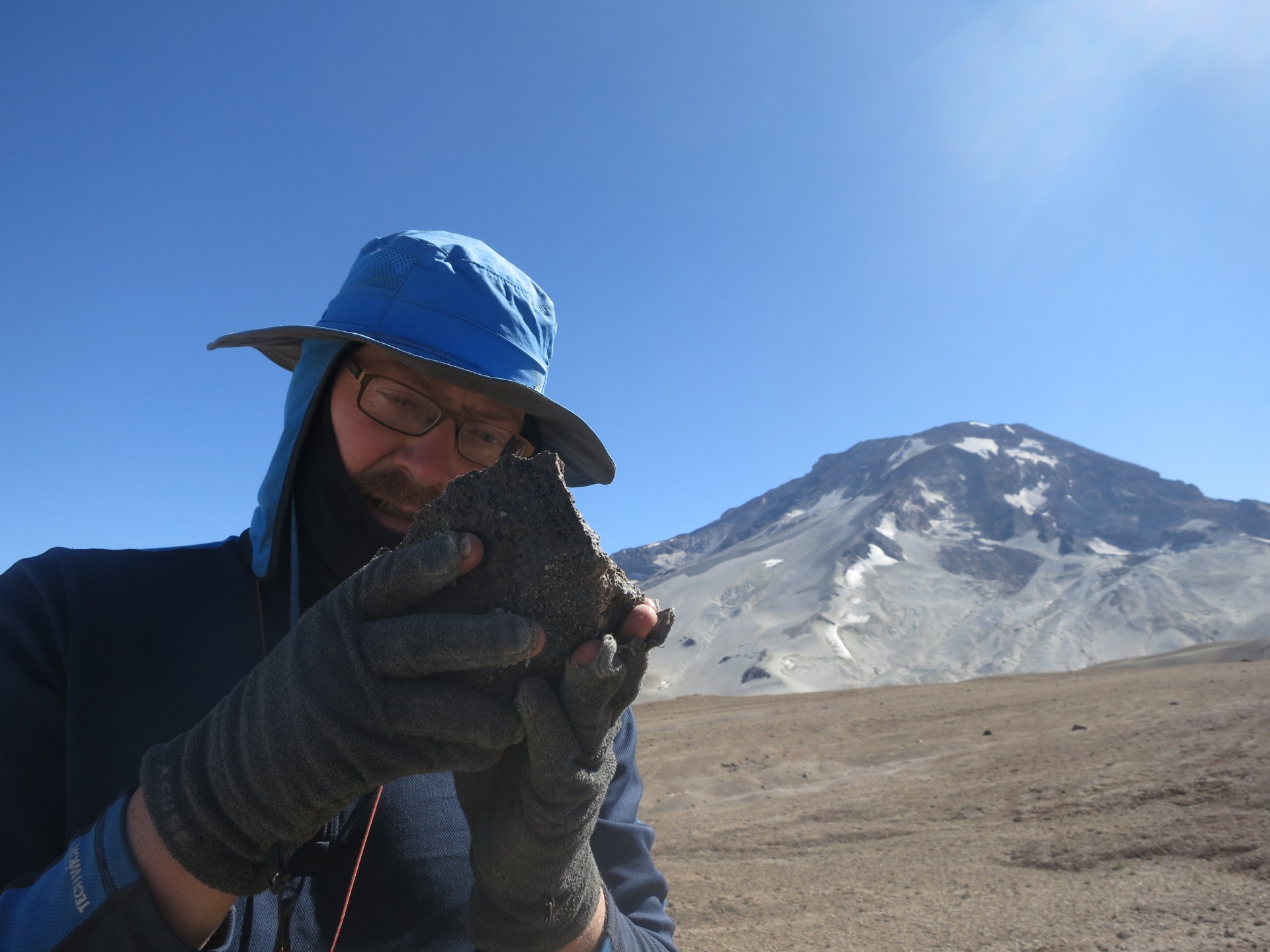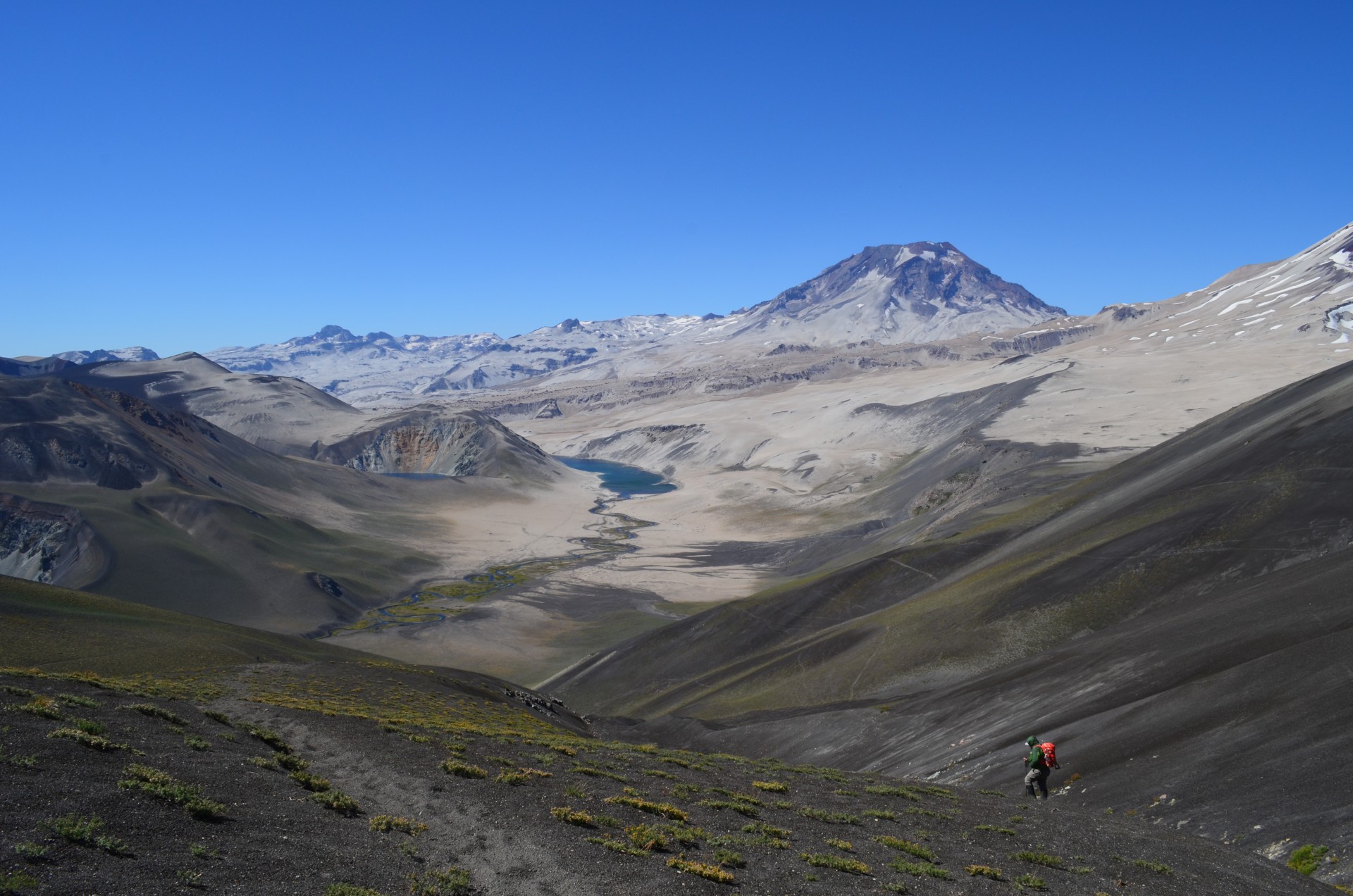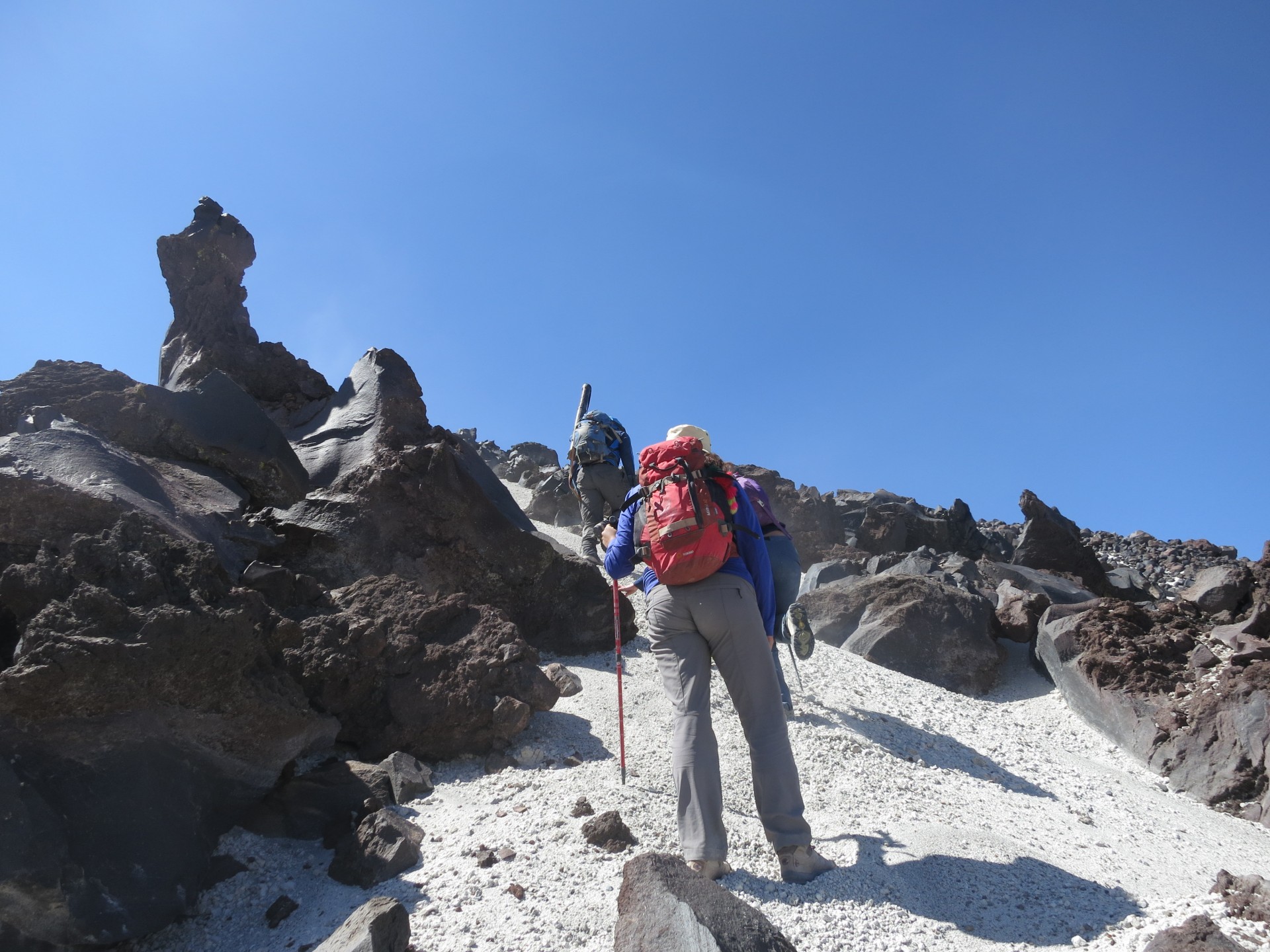Walking in the Shadow of a Great Volcano
On a ledge just inside the lip of Chile’s Quizapu volcanic crater, Philipp Ruprecht was furiously digging a trench. Here at an elevation of 10,000 feet, a 1,000-foot plunge loomed just yards away, and wind was whipping dust off his shovel. But the volcanologist was excited. Ruprecht had just found this spot, topped with undisturbed wedding-cake layers of fine, black material that the crater had vomited from the deep earth some 84 years ago. Samples from the currently inactive site might shed light on its exceedingly violent behavior.
On a ledge just inside the lip of Chile’s Quizapu volcanic crater, Philipp Ruprecht was furiously digging a trench. Here at an elevation of 10,000 feet, a 1,000-foot plunge loomed just yards away, and wind was whipping dust off his shovel. But the volcanologist was excited. Ruprecht had just found this spot, topped with undisturbed wedding-cake layers of fine, black material that the crater had vomited from the deep earth some 84 years ago. Samples from the currently inactive site might shed light on its exceedingly violent behavior.
In 1846-47, Quizapu (kee-SAH-poo) sent out one of South America’s largest historically recorded lava flows, covering some 20 square miles in giant heaps of rock. Then in 1932, it produced one of the continent’s largest recorded volcanic explosions—a cloud of ash- to boulder-size material that instantly turned some 400 square miles to desert. Today, the roadless, arid region around Quizapu is a volcanic wonder park, looking as if the eruptions happened yesterday. The main visitors are the occasional geologist and a few arrieros—horse-mounted livestock herders—on their way to somewhere else.

Ruprecht, based at Columbia University’s Lamont-Doherty Earth Observatory, has worked in this region for more than a decade. This time, he had brought along six other American and Chilean scientists, and a dozen students. Their eight-day, 55-mile trek in February 2016 was aimed at better understanding the forces that drive Quizapu. Ruprecht was also hoping to increase Chile-U.S. scientific collaboration, as well as instruct the students.
Volcanoes are central to life in Chile. Thirty-six have erupted in the last few hundred years, and many more could start up at any time. All are fueled by tectonic plates under the Pacific Ocean floor thrusting deep under the Andes. One spot or another is almost always sputtering to life; in early 2016, it was the Nevados de Chillan complex, south of Quizapu. The capital city of Santiago is built completely on the products of a long-ago super eruption. Chile’s vast copper deposits, which form a third of the world supply, were created by volcanic processes.

Ruprecht’s main question: Why does Quizapu (along with some other volcanoes) erupt in dramatically different ways at different times? In the 19th century, it effused slow-moving lava, but in the 20th, it simply exploded. How can we forecast the difference? Lava flows are threatening—but contrary to popular assumption, almost all volcanic death and destruction comes during explosions like the 1932 event. Chilean scientists monitor Quizapu and other volcanoes for signs of movement, yet they do not completely understand how to interpret the results.
The Quizapu crater lies between two even more gigantic volcanoes: the 12,428-foot Cerro Azul, and 12,970-foot Descabezado Grande. Before the 1840s Quizapu eruption, a major trans-Andean livestock trail passed between these two cone-shaped peaks. Neither has erupted in historical time, but historical time here is relatively short, beginning with the Spanish occupation of the 1500s. The area all around is pocked with huge, young-looking explosion craters and lava flows, all thought to be manifestations of the same active underground complex.
On Nov. 26, 1846, an arriero traversed the pass without noticing anything unusual. But later in the day, a comrade who had stayed behind heard a great noise. This soon evolved into a continuous roar punctuated by cannon-shot explosions, thunder, lighting and blue flames. He was partly enveloped in noxious gases. The noise and fumes soon reached the lowland city of Talca, some 50 miles off. Quizapu had been born. Ten days later, when the arrieros tried to get through the pass, they found it no longer existed. Eventually, it and neighboring valleys were inundated by towering, hardened lava rivers up to 10 miles wide. No one was killed, but the immediate area was now an impassable desert of sharp-edged rock.

In 1907, Quizapu revived, and started kicking out explosions of airborne ash. This continued off and on for years. In 1928, a big earthquake knocked down many of Talca’s old buildings. It may or may not have had any connection to the subsequent eruption of Quizapu.
On April 10, 1932, an unusual grey-green cloud spread out from Quizapu, and the volcano began to bellow like a bull, according to observers. Over the next 24 hours, an umbrella of debris nearly 20 miles high mounted into the skies. Explosions rattled Santiago, 150 miles north. As the cloud collapsed, incandescent pumice rained down—near the crater, boulders the size of pickup trucks, with progressively finer material falling further out. Fine ash reached Rio de Janiero; Cape Town, South Africa, saw strangely colored sunsets, reflected off floating dust. Farms and cities in the lowlands were spared, but all around Quizapu, mountain pastures once grazed by arrieros’ livestock were mantled with pumice, instantly converted to deserts that form an excellent analog to the surface of Mars.
The recent expedition included scientists from Lamont and the universities of Hawaii and Michigan, along with a dozen students from Lamont, the University of Chile (Santiago) and the University of Concepción. Before setting out, the group met in Santiago for a half-day briefing. (Space was provided by the Columbia Global Centers office there; the trip was funded by the Columbia University President’s Global Innovation Fund, which seeks to expand the centers’ work.) The group traveled by bus to Talca, and from there, a couple of hours by paved roads into the mountains.

The bus then turned onto a dirt track and ascended beyond treeline. Soon, we were bumping along the road through a barren landscape of volcanic rocks and cinders. The road dead-ended at Laguna Invernada, a mile-high lake created by a government-owned hydropower dam. Behind it towered the giant mass of Cerro Azul, capped with clouds and a lightning-rod spire of sheer rock. Quizapu itself lay hidden behind the peak. The remote dam, relatively new, is an example of how expanding human infrastructure can run up against natural hazards; when (almost certainly not if) any nearby volcano revives, landslides, lava or ejecta could wreck the whole place in minutes.
From here, the team started its foot journey, hiking several hours up a steep horse track that wound up through surrounding slopes. It was tough walking, through loose, pebbly debris, and it would be repeated every day in this up-and-down landscape. In the steepest parts—which was most parts—it was often two steps forward, one slide back. Finally we emerged through a pass into a hidden valley occupied by another, higher lake, at around 6,200 feet. This lake had been made naturally, when falling volcanic cinders had blocked a creek bed, maybe just a few hundred years ago. Such dead-end drainages are characteristic here—in this arid region, the only places where water collects, and provides a rare oasis.
At the lake, we met a small group of horse-mounted arrieros with strings of pack animals in tow. Ruprecht had hired them to carry our food, water, tents, tools and other heavy stuff that would be impossible for us to lug on foot. They were led by Don Carmelo Adasme, a garrulous man of about 40, whose family has lived in the region for over a century. We ourselves remained on foot, but the journey would have been impossible without the knowledgeable arrieros and their incredibly strong, surefooted horses.

Next day we climbed out of the lake basin along a zigzag route to a higher pass, elevation 8,400 feet. This took much of the day. At the top was a small snowfield and a perfectly barren ridge of dark cinders, swept by a staggering wind. By this time, many of us were struggling to keep climbing, but at the very top, the world changed completely, and it all seemed worth it. Before us lay the world of Quizapu—a precipitous panorama of high peaks, explosion craters and dark lava flows. Much of it seemed covered by snow. Actually, it was not snow, Ruprecht informed us; it was the vast mantle of whitish pumice that Quizapu had spit out. The crater itself still lay out of sight, hidden within the complex topography. We half-slid-half walked down into a deep valley below, and camped for the night.
In the morning, we split into teams, each with a different mission. One was led by Lamont volcanologists Einat Lev and Elise Rumpf. They lugged along a small camera-equipped drone, with which they intended to make high-resolution topographic surveys of the 1846 lava flow. After a long hike, they mounted part of the flow itself, set up the helicopter-like drone, and sent it up. Despite strong winds, they managed to keep the craft aloft during several launches, and it flew a series of preprogrammed grids. That is, until it veered into a mountainside and crashed on a seemingly impossible-to-reach scree slope. The scientists did not flinch. “OK, let’s go get it,” said Rumpf. They half-walked, half-crawled up the slope and a while later returned with the machine. They later repaired it, and it flew without incident on subsequent days.

The following day, the whole group crossed the lava flow’s main arm. Here, you could see the upside to the later pumice eruption: It had conveniently covered much of the lava, making it more or less passable. Craggy masses of volcanic rock still stuck out like islands, but in between was plenty of light, pebbly stuff that people and animals could walk on. A few tufts of alpine grass had even taken root, and lizards darted here and there. “If there was more rainfall around here, this probably would all be revegetated by now, and the geology wouldn’t be visible,” said Ruprecht. “That’s why this is so great.”
On following days, the scientists and students would fan out over the flow to bang off dozens of lava samples with sledge hammers. Chemical analyses would later be combined with drone footage and other data to create a picture of how both the lava flow developed, and why the later, more explosive eruption followed.
Ruprecht favors the idea that just before the 1846 eruption, extremely hot material from the deep earth suddenly flowed up into a chamber of shallow, cooler magma. This addition—it might have only taken days or weeks, he said—may have propelled the whole mass to the surface. But at the same time, it also would have heated the shallower magma and made it less viscous. Less viscosity would mean that pent-up gases could bubble out more easily, so that when the eruption did surface, it was as a relatively benign liquid. Intact crystals of rare deep-earth minerals in the lava samples we took reinforce this idea. So do earlier chemical analyses showing that the 1846 material was much hotter than the 1932 stuff. The 1932 eruption appears not to have gotten any heating from below; it just built up on its own, until trapped gases and everything else finally escaped in one stupendous blowout.
“You would not want to be here when that happened,” said Ruprecht. “You would either be burned or buried alive, but you wouldn’t have much choice about which came first.”

After crossing the lave flow, we descended into a rare green valley where gurgling warm springs emerged from the rocks—probably a product of ongoing magmatic activity below. It was also the trip’s only chance to bathe. On a far ridge stood the area’s only permanent human infrastructure—a transmitter for a seismometer used by government scientists to detect rumblings that might signal renewed trouble.
The following day, we hiked back up the lava flow and made a waterless camp at 7,500 feet—staging point for the final climb to the mouth of Quizapu. Next morning, we trekked upward through an increasingly blasted landscape. All signs of life disappeared, but for a couple of giant condors wafting on winds high above. The pebbly pumice gave way to ever-larger chunks—head-size, body-size and, near the still-invisible crater’s foot, pickup-truck-size. The final steep rubble slope around the rim was almost impossible to mount: rocks sliding underfoot, constant wind driving dust in our faces, and ever-thinner air. One scientist later admitted to crying on the way up. Ruprecht was exultant.

Instantly upon reaching the rim, we were looking into the volcano’s half-mile wide eye. It pierced innumerable jumbled layers of rock, twisted into crazy angles by the force of its last eruption. Wind was gusting hard enough to hurl a person into the abyss. Cautiously, people crept to the edge and lay down flat to inspect the depths. Presently Ruprecht and Julia Hammer, a geologist at the University of Hawaii, walked to a spot where they could safely climb inside the crater a few dozen feet along a sloped ledge covered with fine, black material. This, they said, was the terminal scoria—the very last huffs from the volcano before it stopped. For them, scientific gold. They shoveled samples of the stuff into a couple of sturdy plastic bags. We all descended for lunch and a long rest in a more sheltered spot. Then, the long hike back to camp. The round trip had taken nine hours.
The next day, we walked down the great lava flow to lower ground, taking rock samples all the way. At a rushing river, we met the arrieros, who had brought a welcome addition: strings of fresh horses, one for each person to ride. Never mind that many of us had rarely or never ridden a horse; the animals and the arrieros knew what they were doing. After a spectacular climb toward another pass, we were borne to a meadow hidden in a high canyon. As night came, the horsemen butchered a lamb and roasted it on a fire. To go along with it, wine and shots of pisco were passed around. Don Carmelo kept everyone laughing with a long stream of stories and jokes.
In the morning, the horses took us over a sawtooth series of passes, to a long downward dip in the landscape. From here, we could see the green of trees looming ahead. The nearest town was still miles off, but Quizapu already seemed far behind, still holding its breath.


